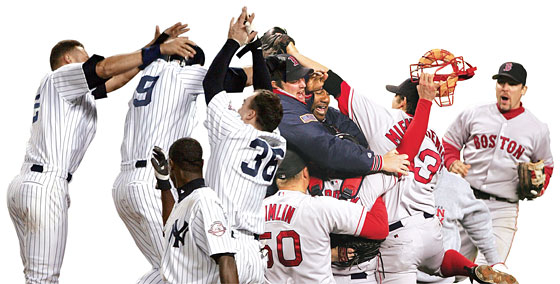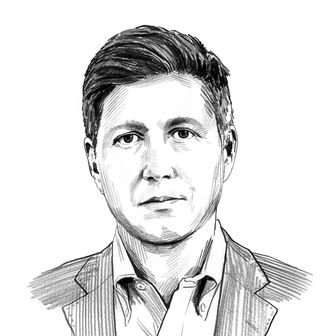
I n 2004, after Aaron Boone but before the great collapse, Chris Smith described a scene from Yankee Stadium in this magazine. “On the night of July 21, the Yankees were sitting comfortably atop the American League East, beating up on the Toronto Blue Jays. In his private box at Yankee Stadium, though, general manager Brian Cashman couldn’t focus on the game unfolding beneath him. ‘What are the Red Sox doing?’ he blurted repeatedly, craning his neck to catch the out-of-town scores scrolling across the scoreboard high above left field.” In baseball, that’s what this whole decade has been: What are the Red Sox doing? What are the Yankees doing? The teams’ hype-drenched, big-money rivalry defined baseball—and it epitomized the entire changing sports world.
The feud’s impact is felt most keenly by those who happen to be fans of other baseball teams. At this point, Major League Baseball has a three-tiered caste system: the Yankees on top, the Red Sox chasing them, and everyone else below. (The Mets could rise above the pack if they spent their ample money even slightly more wisely.) To wit: The Blue Jays attempted to move ace pitcher Roy Halladay last summer but didn’t want to trade him inside the AL East. But, given what Halladay would require to be signed long term, they found their top suitors were … the Yankees and the Red Sox. So he stayed with the Jays, but maybe not for good: Reports say the team has recently resigned itself to the reality that it will have to negotiate within the division, and the Yanks or the Sox are expected to end up with him.
Within the two teams themselves, nothing dictated a course of action as much as what the other guy was doing. In competition mostly with each other, the Yanks got Jose Contreras and the Sox got Daisuke Matsuzaka. The Yanks ended up with A-Rod, whose availability they looked into only after the Sox failed to close a deal with the Texas Rangers. Mark Teixeira became a free agent when both teams needed a first-baseman: Most of the other teams in the game didn’t even bother bidding. Each rival’s main consideration was outflanking the other guy, because it could safely be assumed that the rest of the league had only a puncher’s chance against either team anyway.
The rivalry also reflected and perhaps to some extent triggered a change in the way the media cover sports. Remember when the sports conversation revolved around Sports Illustrated, which earnestly lavished its attention on whatever sport—tennis, IndyCar racing, hockey—was having a signature event at the moment? This has been the decade of ESPN, of Tiger Woods, of Lance Armstrong, of Favre, Favre, and more Favre, of fixating on the handful of major teams and stars with the power to boost national ratings. Every story line got blown out—The Greatest Super Bowl Ever, The Gunslinger Returns. Such claims were made before 2003—but when those Yankees-Sox American League Championship Series actually lived up to the hype, it was like lighting a fuse.
